Standard [CURRENT]
ASTM D 8572:2025
Standard Practice for Determining the Impact of an Asphalt Additive on Unaged Asphalt Binder Rheology Using Dynamic Shear Rheometer
- Publication date
- 2025
- Original language
- English
- Pages
- 3
- Publication date
- 2025
- Original language
- English
- Pages
- 3
- DOI
- https://dx.doi.org/10.1520/D8572-25
Product information on this site:
Quick delivery via download or delivery service
Buy securely with a credit card or pay upon receipt of invoice
All transactions are encrypted
Short description
1.1 This practice covers test methods and equations for calculating percent change between two laboratory-blended asphalt binder samples, typically a neat asphalt binder and an asphalt binder blended with an additive material. The percent change can be used to identify a dosage level of additive that yields an agency-accepted asphalt binder G*/sin δ property range. This calculation is based on G*/sin δ values using laboratory-blended unaged asphalt binder. The intent of this standard practice is to conduct a relatively quick evaluation of the percent change between pre-blended and post-blended asphalt binder samples. 1.2 Units- The values stated in SI units are to be regarded as the standard. No other units of measurement are included in this standard. 1.3 The text of this standard references notes and footnotes which provide explanatory material. These notes and footnotes (excluding those in tables and figures) shall not be considered as requirements of the standard. 1.4 This standard does not purport to address all of the safety concerns, if any, associated with its use. It is the responsibility of the user of this standard to establish appropriate safety, health, and environmental practices and determine the applicability of regulatory limitations prior to use. 1.5 This international standard was developed in accordance with internationally recognized principles on standardization established in the Decision on Principles for the Development of International Standards, Guides and Recommendations issued by the World Trade Organization Technical Barriers to Trade (TBT) Committee.
ICS
91.100.50,
93.080.20
DOI
https://dx.doi.org/10.1520/D8572-25
Also available in
Loading recommended items...
Loading recommended items...
Loading recommended items...
Loading recommended items...

